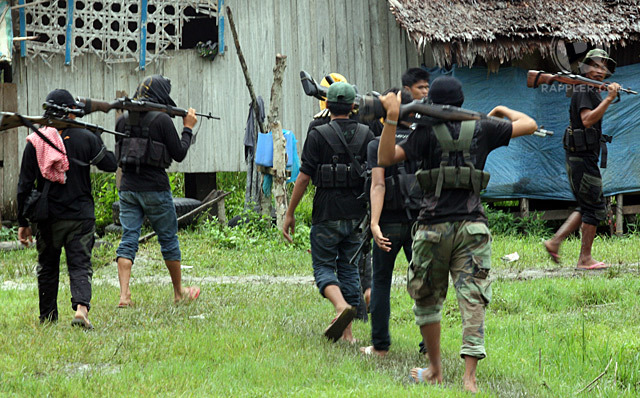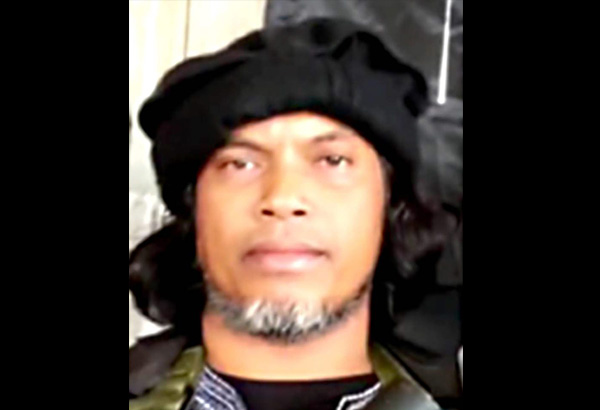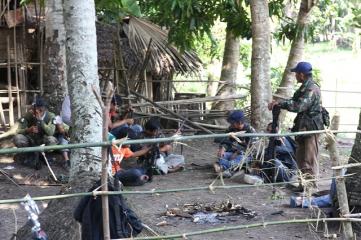CPP propaganda statement posted to the CPP Website (Feb 21):
Intensify people’s struggles in the face of the US-Aquino regime’s political crisis

CPP Ang Bayan
A serious political crisis is currently shaking the ruling regime as a result of disclosures regarding the direct responsibility of Benigno Aquino III and US military officials in the bloody Mamasapano operation on January 25.
Aquino’s persistent shirking of his accountability and his coverups of the truth have further enraged the Filipino people and fired up their desire to oust the puppet, corruption-ridden, brutal and deceptive regime.
The Aquino regime is now scrambling to find a way out of the political crisis through a series of measures designed to prevent the truth from coming out and using government funds to create diversions and prevent the people from casting blame on the US and Aquino for the deaths of more than 80 people, including 44 special police troopers, paramilitary forces, Moro fighters and civilians.
Indicating the depth of the people’s anger at the ruling regime, a number of PNP Special Action Force (SAF) elements who joined the Mamasapano sortie have revealed the truth regarding US military officers’ direct hand in training for, planning and executing the operation. These exposés reveal the Aquino government’s high treason as it acted as the US military’s errand boy in undertaking the mission to liquidate Zulkifli bin Hir who had a $6 million reward on his head offered by the US State Department.
In an attempt to stop the disclosure of classified information that would pin the blame on Aquino and the US, the Filipino people were banned from viewing, and listening to, the ongoing investigation at the Senate dominated by pro-Aquino and pro-US politicians. Should such information be made public, it would certainly be “sanitized” to avoid further stoking the people’s anger. Congressional hearings, on the other hand, have been indefinitely suspended out of fear that Aquino’s officials would be put on the defensive by the questioning, especially by progressive legislators who are determined to ferret out the whole truth about the Mamasapano incident.
Despite the tens of millions of pesos given by Malacañang to the relatives of the slain police troopers, it has failed to stifle their complaints and grievances about the abandonment of the troops who had been besieged in the operation. The families of the slain SAF troopers are likewise in possession of a lot of information that may further point to the accountability of Aquino, his closest people and the US military.
The Aquino government continues to distort the truth about the US’ role. Aquino’s officials claim that “there is nothing wrong” with US military “assistance,” as if it were not the US that masterminded the whole operation.
The Aquino government’s persistence in covering up and distorting the truth about the bloody Mamasapano operation merely enflames the Filipino people’s desire to go through all the pieces of information they have dug up and make sense of them in order to discover, above all, Aquino and the US’ responsibility in planning and undertaking the operation. The broad masses refuse to accept Aquino and his officials’ statements and depictions of what happened. This is reflected in the demands made by members of the Catholic Church hierarchy for the Aquino government to come out with the whole truth.
Aquino’s suppression of the truth about Mamasapano and his attempts at a coverup are fuelling the Filipino people’s widespread anger at the ruling regime and further stoking calls by broad sectors to oust Aquino from power.
Demands for Aquino’s resignation go far and strong. His severe isolation likewise emboldens his reactionary political rivals and their cohorts among the military and police top brass to join people’s actions and turn their backs at the ruling regime. A number of religious leaders have also expressed solidarity with calls to form a democratic council that would take over once Aquino resigns.
The Filipino people deeply desire to oust the Aquino regime because of its corruption and brutality, its puppetry to the US and its deceptiveness. It has perpetrated myriad crimes against the people. The bloody operation in Mamasapano was but the latest in a long list of transgressions that have caused the people’s suffering, oppression and repression.
We must gather the people’s anger, forge their unity and unleash their power through widespread street protests. All sectors, groups and personalities who are one in their demand for accountability from Aquino for his leading role in the Mamasapano operation must be united. The patriotic forces must relentlessly expose and assail the US military for masterminding the operation in violation of Philippine national sovereignty.
The workers and the toiling masses must strengthen their mass actions to hold the US and Aquino accountable for the bloody Mamasapano operation. More important, this demand must be closely linked to the issues of raising the minimum wage, rollbacks in metrotrain fares, prices of oil and other commodities and power and water rates and higher budgets for education, health and other social services.
This way, they can unite the broader ranks of the toiling masses for them to serve as a major force in mass actions and measures to oust Aquino from power and further advance their struggles under the post-Aquino government.
The New People’s Army (NPA) must intensify armed struggle and take advantage of the turmoil within the AFP and PNP officer corps. The biggest blows must be meted on the officers and units that have been most brutal and repressive on the people and in defending the rotten Aquino regime. Let us encourage the disgruntled military and police officers and rank and file to turn their backs on the Aquino regime and join the revolutionary movement or cooperate with it.
In the coming months, all NPA commands must launch tactical offensives to contribute to the people’s struggle to end Aquino’s rule. This, in consonance with advancing agrarian struggles and expanding and consolidating organs of democratic people’s government. The revolutionary forces must give their all in order for the protest actions and struggles against the US-Aquino regime to contribute to the all-sided advance of people’s war nationwide.


















